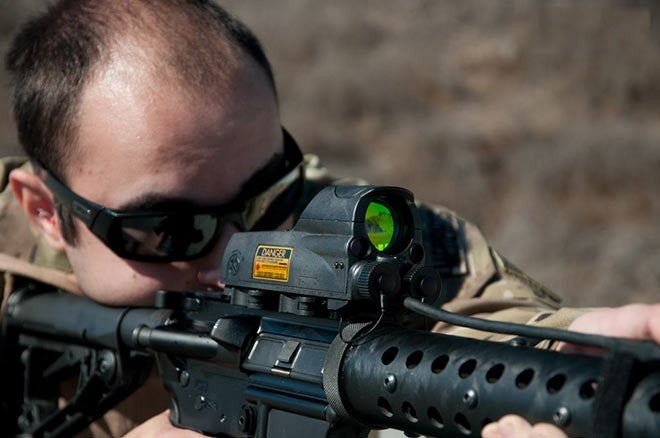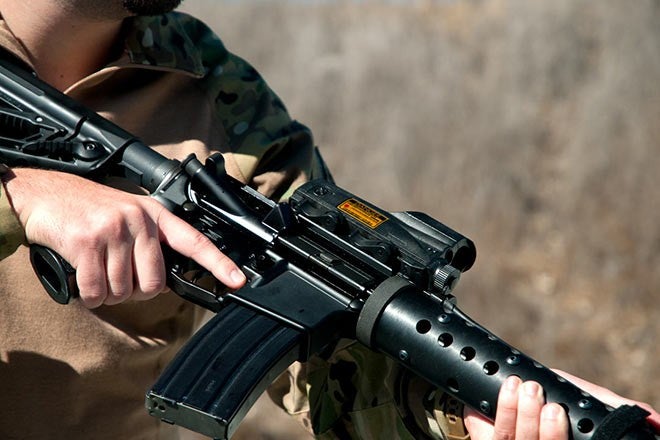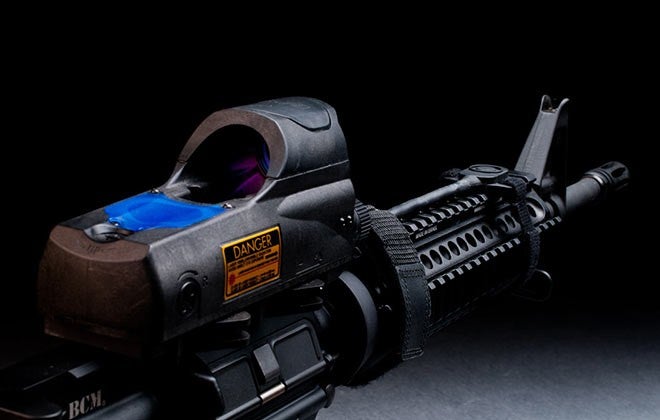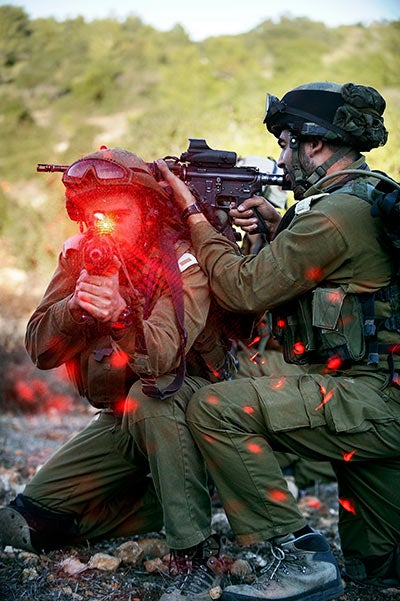The Israeli Defense Forces (IDF) were one of the first militaries to understand the importance of an optic equipped rifle for every infantryman. The standard reflex sight of the IDF is the Meprolight M21, but a select few in each unit are issued a specialized reflex sight with a built-in laser designator. The first in this new class of sights was the MARS (Multi-purpose Aiming Reflex Sight). The MARS integrated an AA battery-powered red reflex sight, dual laser designators and a tethered pressure switch for activation in a single unit.
A small number of MARS sights were acquired by the US military during the early days of the War on Terrorism and the US Marines used it in the furious close-quarter fights during the Battle of Fallujah. However, the MARS sight was quickly withdrawn from US service due to some severe design drawbacks. The MARS has a ruggedly built cast aluminum housing but this makes it a bit heavy at almost 16 ounces. The field of view is narrow for a reflex sight due to its smallish 25mm objective lens. The biggest complaint against the MARS was the short 200-hour battery life. Backup iron sight were out of the question since the MARS is too tall to allow for a proper co-witness.
The IDF isn’t happy with the MARS either, but they have retained it in service since it’s the only commonly available weapon mounted laser designator they have in inventory. I have been told that IDF is not buying any new MARS sights and their last order was many years ago. Meprolight was tasked by the IDF to develop a replacement for the MARS. In 2010, Meprolight released the Mepro MOR and it quickly became the favorite weapon sight of the IDF Special Forces.
The Meporlight MOR features a 3 MOA dot which is on the large size with Aimpoint offering 2 MOA dots and EOTech offering 1 MOA dots. The 30mm objective lens on MOR offers a similar field of view as most of the reflex sights on the market. The lens uses a greenish coating like the M21 but the lens seems to be a bit brighter on the MOR.
The Meprolight MOR mounts to any 1913 style picatinny rail by way of its dual QD levers. On my AR-15, the MOR has a lower sight height than the MARS but it’s still too tall for an effective co-witness with the iron sights. The tops of the iron sights are barely above bottom of the lens. The Mako Group told me that the IDF is not concerned with using backup iron sight with the MOR since it offers redundancy from its dual reflex sights and lasers.
As indicated on the title, the Mepro MOR has a tri-powered illumination by fiber-optic, tritium and battery powered. It’s not the first optic to use tri-power. A better-known reflex sight that has a similar tri-power illumination is the Trijicon TX30 TriPower. The Trijicon is known to have similar drawbacks of of the MARS, namely a short battery life. It also suffers from dim tritium and light leak through its fiber optic collector when battery illumination is in use. Even Trijicon is admitting that the TriPower is not a successful product.
Internally, the Meporlight MOR is actually made up by two reflex sights stacking one in front of another, The front one is fiber-optic and tritium powered. Right behind that is the battery powered reflex sight. The use of dual AA batteries is for combat redundancy, since the Mepro MOR will function with just single AA battery. Even if the last battery die, there’s still the fiber-optic and tritium illumination.
The tethered pressure switch for laser activation can be mounted to the handguard of an AR15 but is designed to fit inside the Tavor’s handguard. The Tavor’s handguard features a special button cutout for concealment of the tether cable and allows for flush mounting the switch on the left side of the front handguard. The tether pressure switch is user replaceable and the different length versions are available.
Don’t try this with any of your laser. An very unique feature of the Mepro MOR is that it uses a single internal zeroing mechanism for both reflex sights and the laser designator, which eliminates the need to zero each component independently. The same two AA batteries power both the sight and the laser for thousands of hours.
The Mepro MOR on the new X95 bullpup. If you have an IDF version of the U.S. Tavor, you can check with the Mako Group to see if they can supply you with the special mount to adapt it to your rifle. Weight in at 15.8 ounces the Mepro MOR is hardly any lighter than the MARS sight that it suppose to replace.
The Mepro MOR with visible red laser is priced at $1200 and the dual red and IR laser model is $1600. The price is high but what you’re getting is two reflex sights and a laser designator all in one unit with triple redundancy. All three aiming systems are also all sync to a single impact point. Comparing to the ridiculously overpriced American-made $1000 Trijicon SRS and the $1200 Leupold LCO, the combat proven Meprolight MOR seems to be a bargain with twice the optics plus a laser too.
The Mako Group, the US importer of the Mepro MOR, is restricted to only allow the dual laser model for LE and military sales only. However, the restriction doesn’t applies to Mako’s reseller such as 7.62 Precsion and there’s a small additional discount on top of that too.
 Your Privacy Choices
Your Privacy Choices








